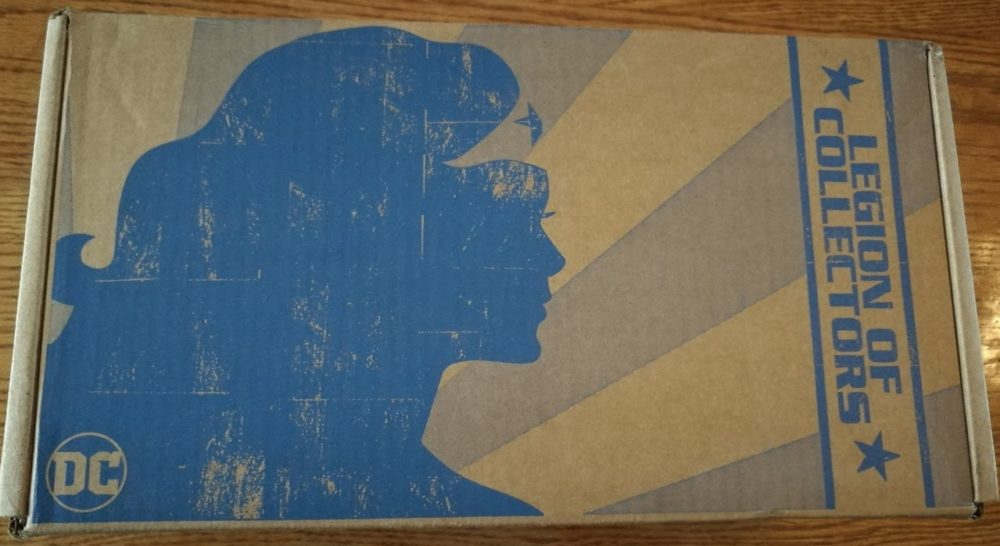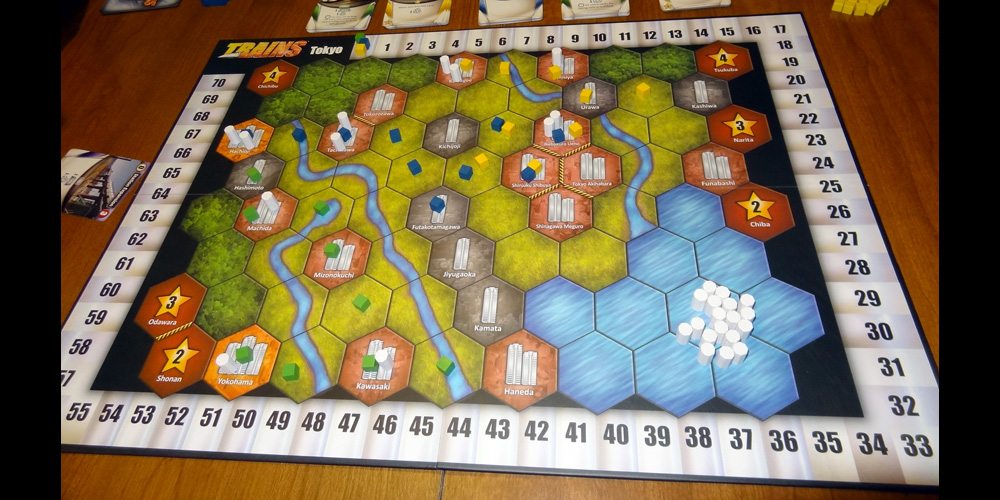Assemble teams of heroes and take on twisted dark multiverse versions of Batman in the latest entry of The Op’s Rising series.
What Is The Batman Who Laughs Rising?
The Batman Who Laughs Rising is a dice-rolling and placement cooperative game for 1-4 players, ages 15+. It takes approximately 60 minutes to play. It retails for $49.99 and is currently available to purchase from Amazon and your friendly game stores. It’s designed by Patrick Marino and Andrew Wolf and published by The Op.
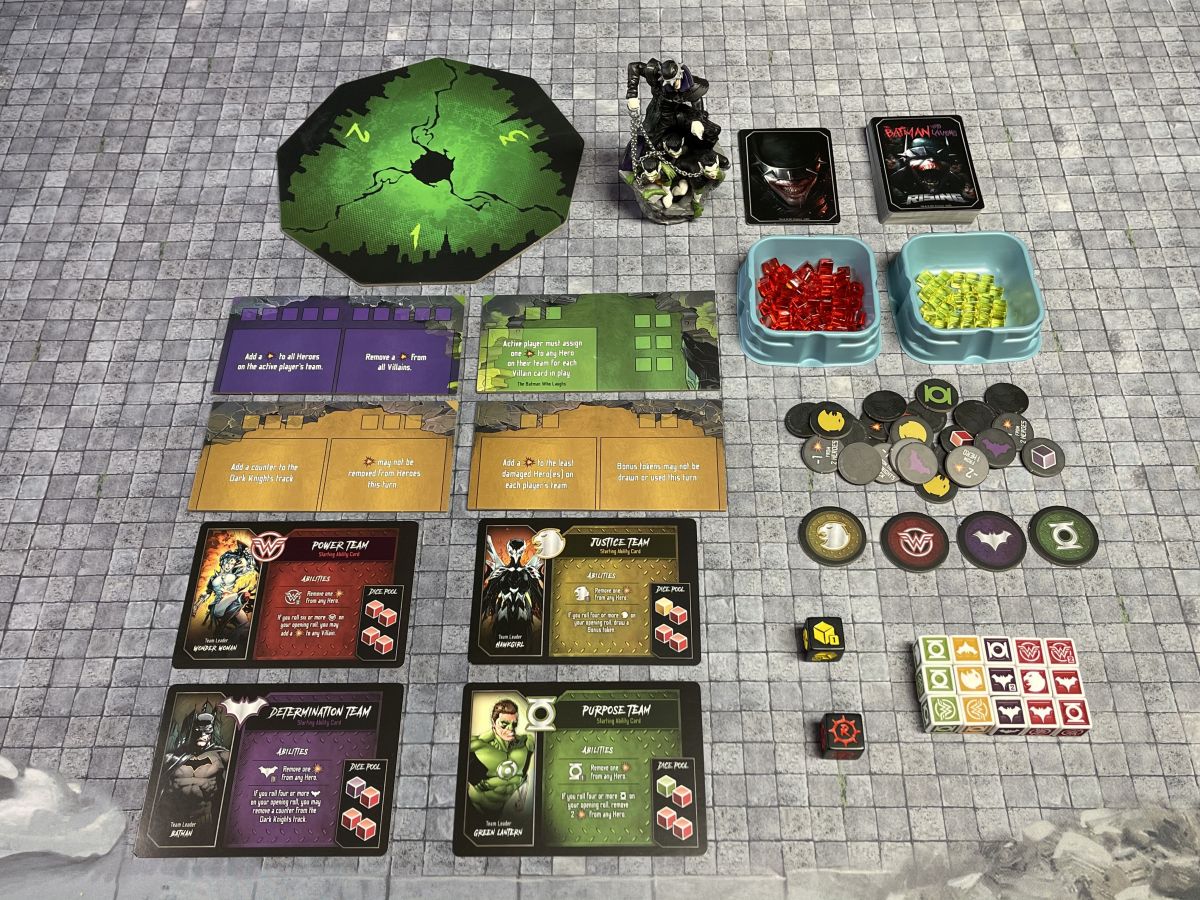
The Batman Who Laughs Rising Components
Here’s what you’ll find inside the box:
- 1 Batman Who Laughs Figure
- 1 Deployment Zone Tile
- 4 Double-Sided Dark Knights Track Tiles
- 1 Dark Knights Die
- 1 Batman Who Laughs Die
- 15 Hero Dice
- 32 Dark Knight Track Counters
- 60 Damage Counters
- 4 Team Deployment Tokens
- 30 Bonus Tokens
- 4 Team Ability Cards
- 38 Character Cards
- 7 Dark Knight Cards
- Rulebook
The components are all of uniformly good quality. The boards are nice and thick and lay flat out of the box.

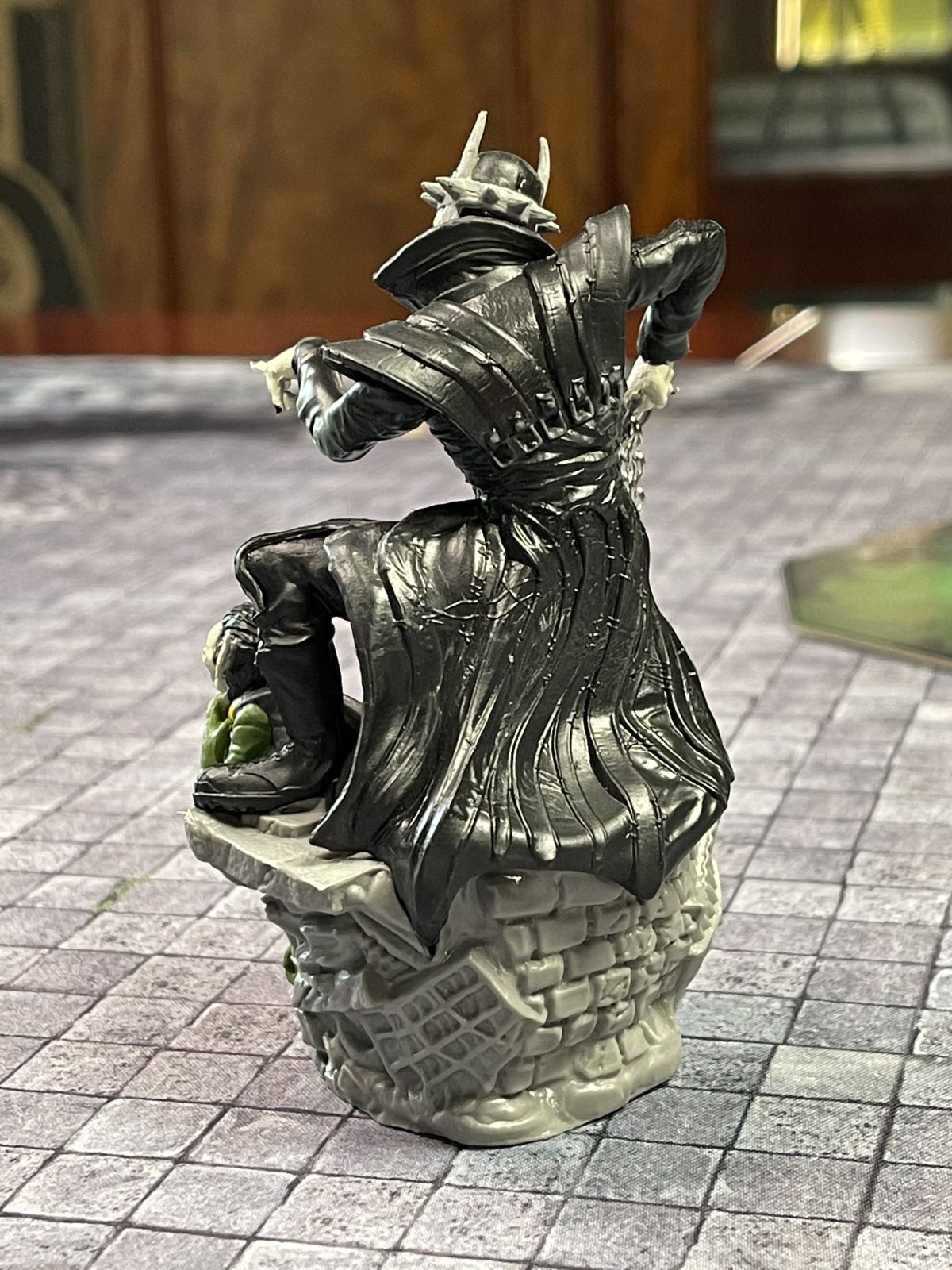
The centerpiece of the game is, of course, the large Batman Who Laughs figure, which will rightly dominate your playing area as the main villain and is used to attack heroes throughout the game. It’s a very nicely sculpted figure with actual metal chains incorporated into the sculpt. It also is painted with a fairly nice, if basic, paint job. I would imagine it would be an easy task for a hobbyist to add some simple shading and highlighting to really make the figure pop, but it’s plenty nice for the average board gamer straight out of the box.
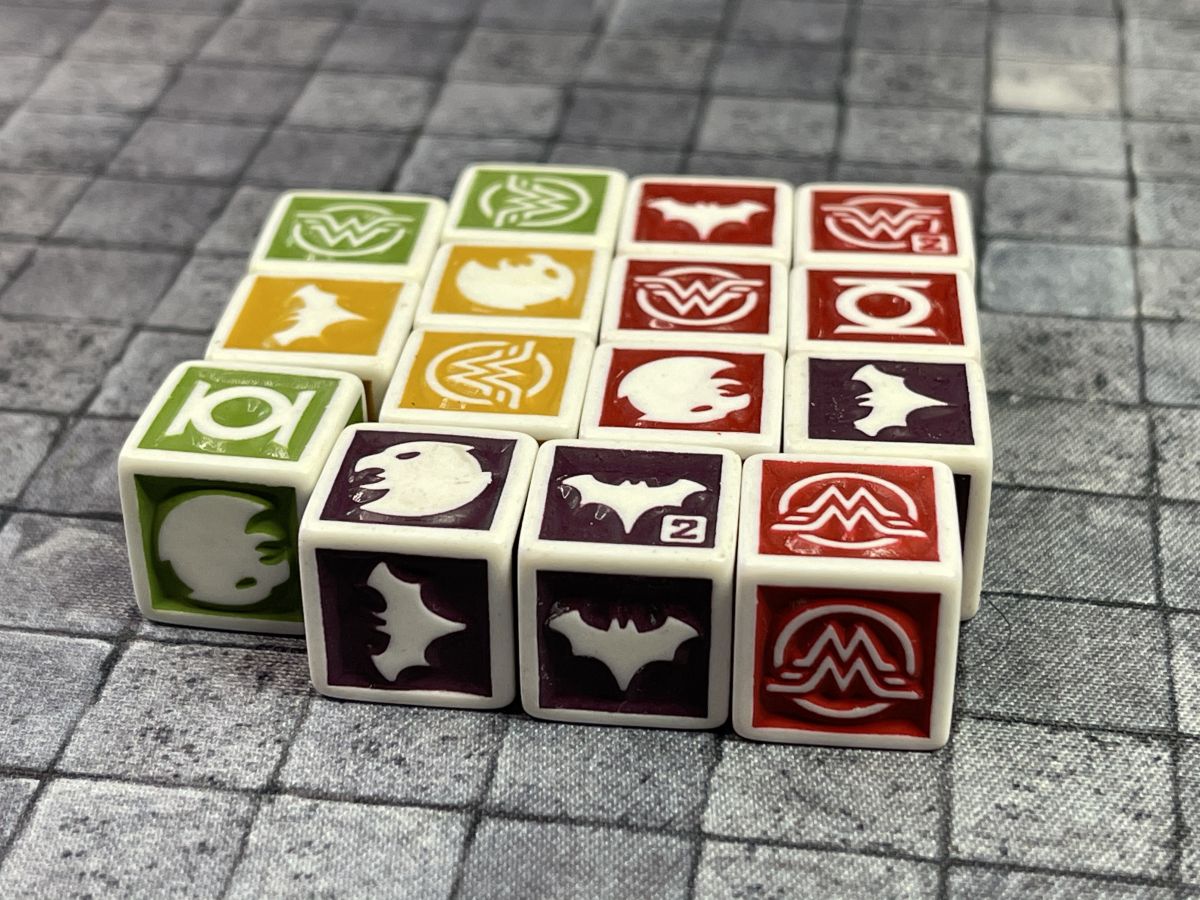
The sculpted Hero Dice all have raised symbols on the faces, and each color is associated with a different team. While all the dice share symbols, there is a double symbol on each one that’s specifically for the associated team. For example, the Determination team (Batman’s team) has a double bat symbol on one of the sides.

Meanwhile, the chunkier Dark Knights and Batman Who Laughs dice are used to advance the Dark Knights track and determine where the villains will be attacking the heroes, respectively. They’re sized comparatively to the dice from King of Tokyo.
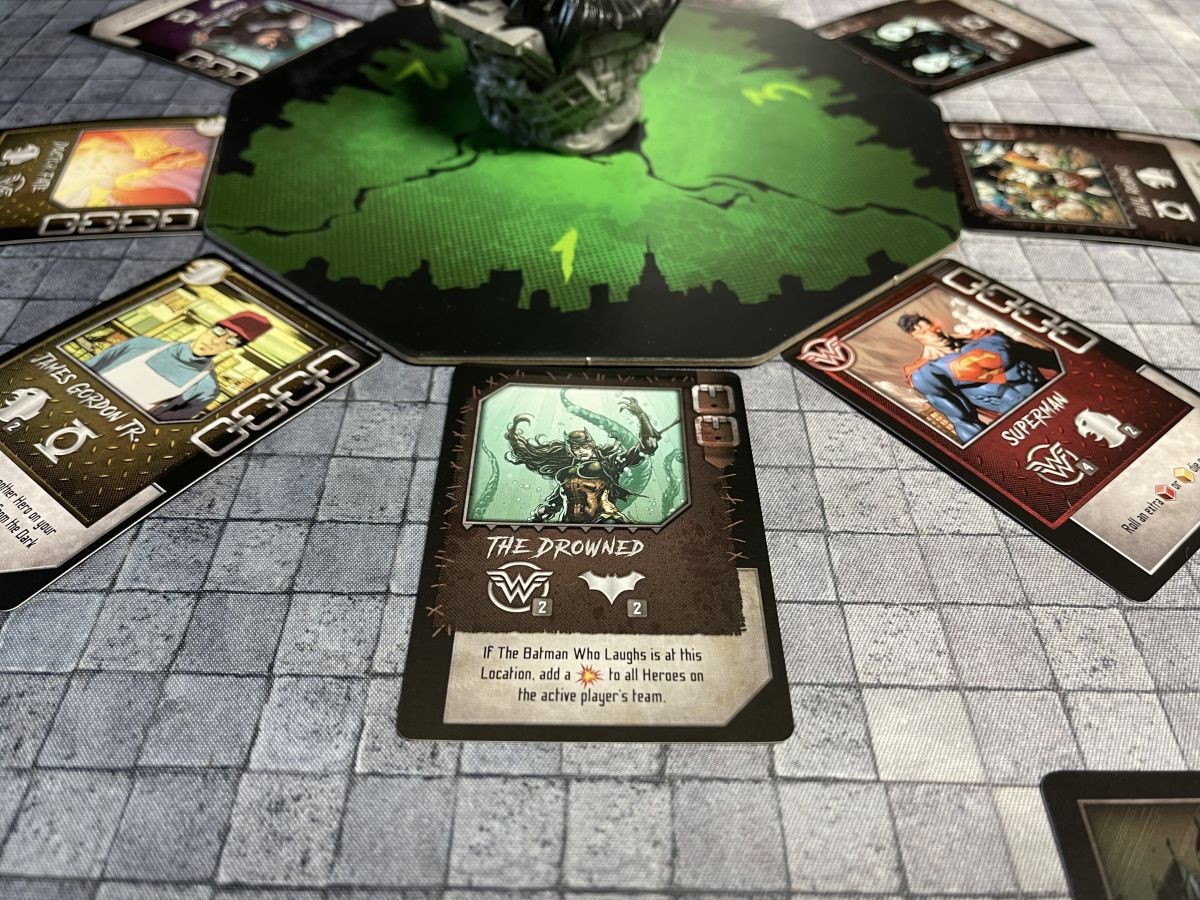
The artwork on the cards seems to be lifted directly from various DC Comics comic books, as I recognize some of the pictures. There’s a nice visual differentiation between the heroes and the villains to easily tell them apart if you’re not familiar with the DC universe: the heroes get a diamond plate metal background on their cards with links in a chain to track their wounds, while the villains have stitched leather with belt buckles for wound trackers.
How to Play The Batman Who Laughs Rising
You can download a copy of the rulebook here.
The Goal
Build up your teams by recruiting heroes and defeating other villains before you face off in a final showdown against the Batman Who Laughs.

Setup
Lay out the Dark Knights Track. If you’re playing with 1-2 players, use the orange side, or for 3-4 players, flip the boards to the purple side. Shuffle the Dark Knights cards, and place one face down on each open space in the track. Place the Batman Who Laughs card face up in the final space. Put the yellow Dark Knights Track counters near the track.
Place all the dice, damage counters, and tokens within easy reach of the players.
Place the Deployment Zone board in the middle of the table, and put the Batman Who Laughs figure on the center of the Deployment Zone, facing randomly towards one of the three sectors.
Each player takes a Team Ability card and its matching Deployment token. Collect the starting Hero Dice as indicated by that card.
Shuffle all the Character Cards and deal out nine cards face up (three for each sector). These are a mix of heroes and villains.
Gameplay
The player who most recently read a DC comic goes first, then gameplay proceeds in clockwise turn order.
Each player’s turn consists of four steps:
1. Place Team Deployment Token in Sector
Take your Deployment Token and place it in any one of the three sectors on the Deployment Zone.
2. Roll and Resolve Dark Knights and The Batman Who Laughs Dice
Roll the Dark Knights die and add the shown number of yellow counters to the Dark Knights track.
Then roll the Batman Who Laughs die. This will show whether the Batman Who Laughs rotates one sector to the left or right or stays where he is. If the die face also includes a red ring, then the most recently uncovered action on the Dark Knights track will also be activated.
The Batman Who Laughs does one damage to every Hero at the sector he is at, including the heroes on the active player’s turn if that player’s deployment token is at that sector. He then triggers the abilities of any Villains at his location, as shown on the villains’ cards.
3. Roll and Assign Hero Dice
The active player collects and rolls their dice pool, which includes the dice shown on their Team Ability card as well as any bonus dice from recruited Heroes or Bonus Tokens. The player must assign at least one of those dice to a card with a matching symbol that is a Hero or Villain at their sector or to an ability on their Team card or a recruited Hero card. They must forfeit a die from their pool if they do not assign one.
The player then rerolls the remaining dice and continues until all dice are assigned.
4. Resolve Hero Dice Roll and Assign Hero Dice
If the right number of dice matching all the symbols on a Hero card at the active player’s sector has been placed on that card, that Hero is recruited. The player removes any Damage Counters on that Hero and adds them to their team.
If dice matching all the symbols on a Villain card at the active player’s sector have been placed on that card, the Villain is damaged. Add a Damage Counter to them, and the active player receives a Bonus Token for each Damage Counter added. Villains and Heroes that have all their spaces filled with Damage Counters are discarded from the game.
Note: Bonus Tokens may be used on any player’s turn except the one on which they are gained to help other players.
Check the Dark Knights Track and remove any Dark Knights cards from sections that have been filled with Dark Knights counters. Put those cards face down on top of the Character Deck.
Finally, draw from the top of the Character Deck to replace any Heroes or Villains that were defeated that turn. Then, it is the next player’s turn.
Game End
As with most cooperative games of this type, there are many ways to lose but only one way to win.
If the players can defeat the Batman Who Laughs before the Dark Knights track is filled, then they win! However, they can’t attack him directly until his card is revealed in the Dark Knights track, and he can only be attacked if a player’s team is at his location. Players may also discard an unused die from their die pool to move to his location.
The Batman Who Laughs takes 1 damage counter for three identical dice of one of the matching symbols. In the picture below, he already has three damage counters. By rolling the three “Purpose” symbols (the Hawkwoman symbol), the final damage counter is generated to defeat him.

Players lose if:
- The entire Dark Knights track is filled with counters.
- Ten or more Heroes are defeated.
- Any player has all the Heroes on their team defeated.
Single Player
To unlock some games with complicated solo modes for The Batman Who Laughs Rising, simply choose two teams and alternate play between the pair.
The Batman Who Laughs Rising: The Verdict
The bad guys in The Op’s other Rising games are instantly identifiable in pop culture: Thanos, Darth Vader, Voldemort. For the first DC Comics game in the series, they chose to go with the Batman Who Laughs, who has featured prominently in recent events in the DC Universe but may be unfamiliar to those who haven’t read a DC comic lately. As a very quick primer, the Batman Who Laughs is a Batman from an alternate earth in the Dark Multiverse. He kills the Joker on his world, and in doing so, unwittingly releases a toxin from the Joker’s heart, which transforms him into the Batman Who Laughs. Most recently, he has come into godlike powers and is attempting to remake the multiverse in his own image.
I’ve only ever played one of the other Rising games, Thanos Rising: Avengers Infinity War, in which you’re teaming up with other Marvel superheroes to try and stop Thanos before he can assemble the Infinity Gauntlet and change reality. The stakes are similarly high in The Batman Who Laughs Rising, where you must stop the Batman Who Laughs before he can destroy the Prime Universe (aka the universe where all the DC superheroes live). Past the difference in settings, the basic gameplay of dice rolling and placement is largely the same between those two games.
Let me be perfectly clear: this is a hard game to win. Much like in Pandemic, you’re constantly putting out fires. Every turn, the Batman Who Laughs is damaging heroes in his current location, and likely so are any villains that are also in that location. And if the active player has unfortunately deployed his team into the location where the Batman Who Laughs ends up, that team’s heroes are also getting damaged. The Batman Who Laughs is relentless, and it’s a rare turn that he doesn’t do some significant damage. And if enough heroes get taken out by the villains, not only will you have a harder time fighting the Batman Who Laughs, but it could also lead to an immediate loss of the game.
You have to make a difficult decision on your turn. Do you try to recruit a hero? And if so, which one? That easy to recruit one who you’re confident you can acquire? Or one like Superman, who adds an extra die to all your rolls but also requires you to really push your luck to get? Or maybe just that one who only has one wound left and will likely die if you don’t recruit him on your turn?
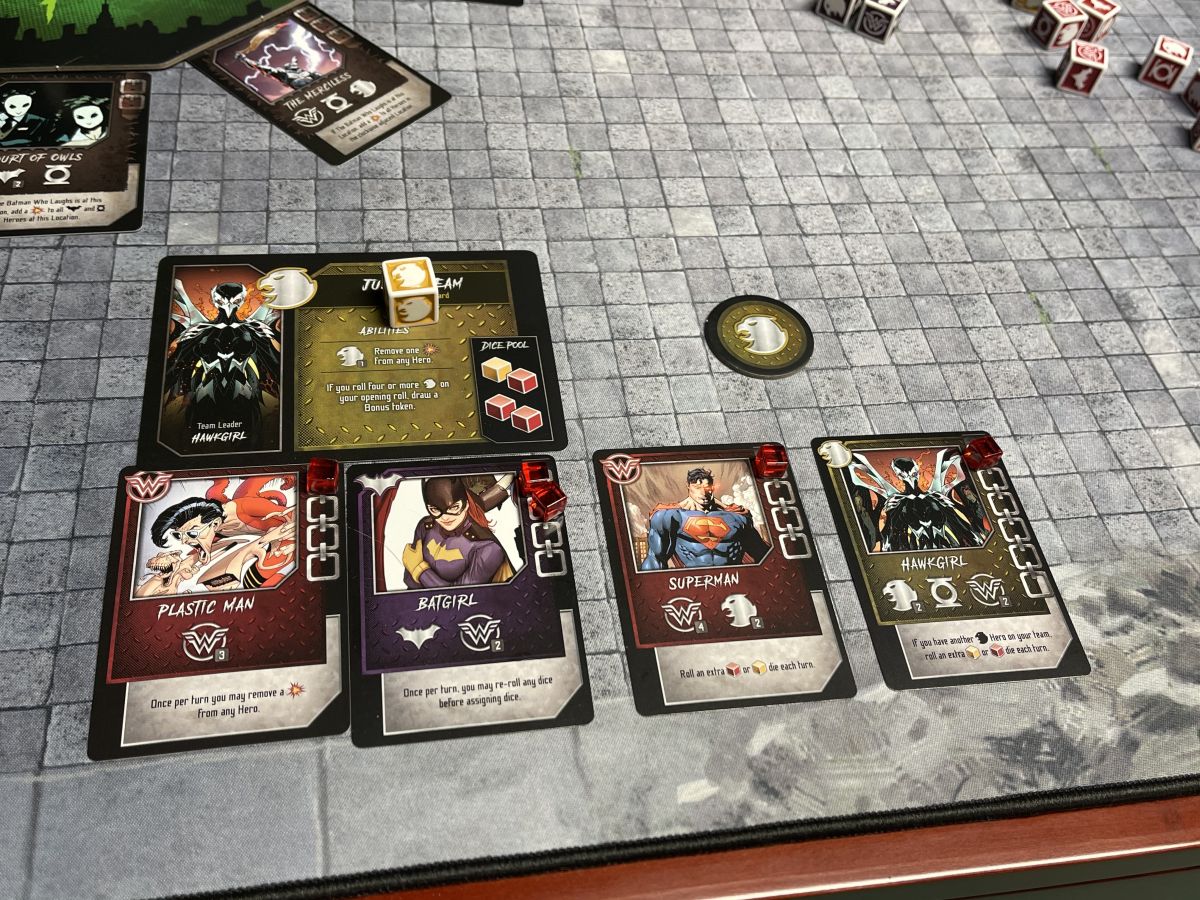
Or do you attack a villain, hoping to draw a good Bonus Token? Maybe you want to use the special abilities of your heroes? There’s rarely an easy answer to what will best help your fellow players… but you won’t help anyone if you don’t at least accomplish something on your turn.
And there will be turns that you get little or nothing done thanks to bad dice rolls. Luck plays a huge factor in this game, something that may turn off strategy purists. The good news, though, there is some dice mitigation in the game. For example, Batgirl allows you to reroll your dice once a turn, and Nightwing lets you change a bat symbol on a die to any other facing once a turn. But you may not always see a hero on the table whose ability you can really use during your game. As a matter of fact, I found in my games that my discard pile was fairly small at the end. And looking through the deck of Heroes and Villains, there were a number that never made an appearance in any of my games.
The level of challenge in The Batman Who Laughs Rising may frustrate those that are looking to just chuck dice and cakewalk through a game. But if you don’t mind a game that you’ll likely lose more than you win, you’ll find it all the sweeter when you do manage to defeat the Batman Who Laughs and save the DC universe.
Click here to see all our tabletop game reviews.
![]() To subscribe to GeekDad’s tabletop gaming coverage, please copy this link and add it to your RSS reader.
To subscribe to GeekDad’s tabletop gaming coverage, please copy this link and add it to your RSS reader.
Disclosure: GeekDad received a copy of this game for review purposes.



